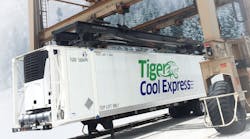Tiger Cool to grow services in Tri-Cities area
Tiger Cool Express is set to acquire a former Cold Connect warehouse.
The lease/purchase agreement with Union Pacific Railroad includes the warehouse and property in Wallula, Washington, which Tiger Cool envisions transforming into a Tri-Cities logistics center benefiting the agricultural and manufacturing communities in the three-state region by providing “cost-effective and environmentally benign” transportation.
The company said it also plans to develop an adjacent intermodal ramp.
“Despite our continued growth and fleet expansion, we realize that the Pacific Northwest offers transformational potential for our company,” Steve Van Kirk, Tiger Cool’s CEO, said in a news release. “With a private intermodal ramp, we can build on our own domestic customer base with their ISO shipping requirements at the same time we expand services to an entirely new community of stakeholders.”
Initially, service is intended to be offered between Wallula and the Northwest Seaport Alliance on-dock facilities for dry imports and exports (in ISO equipment), as well as between Wallula and Chicago (and beyond), with Tiger Cool refrigerated domestic containers. Service scope eventually will expand into other markets, such as the I-5 corridor and Mexico, the company said.
“We are enthusiastic about Tiger Cool Express advancing an initiative that will remove thousands of trucks and millions of truck miles from the highway,” said Kari Kirchhoefer, vice president of marketing and sales at Union Pacific.” This is a region that continues to grow in logistical importance, and our network can support envisioned growth.”
Theodore Prince, Tiger Cool’s chief strategy officer and co-founder, said the Tri-Cities facility has the potential to be a “triple threat,” with the land, labor, water, and electricity to make it a “global logistics hub.”
“Since the other import ‘corners’ (Southwest, Northeast, and Southeast) lack adjacent land, this Northwest facility could offer an environmentally benign and economically efficient transloading locus,” he said.
“It looks like the Inland Empire 30 years ago.”



